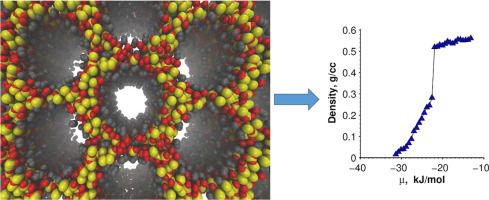Microporous and Mesoporous Materials ( IF 4.8 ) Pub Date : 2017-12-07 , DOI: 10.1016/j.micromeso.2017.11.045 Evan Lowry , Mohammad Piri

|
It is well known that fluids confined within nanoporous media often experience drastic and unexpected changes in thermodynamic properties. Recent research has focused on uncovering the mechanisms as well as pore size dependent effects. Unfortunately, very little insight is available for how pore wall chemistry and heterogeneity affect the fluid phase behavior. In this study, grand canonical Monte Carlo (GCMC) simulations were employed to investigate the effects of three different pore types on the fluid phase behavior and thermodynamic properties of ethane. Pores were created in sizes ranging from 3 nm to 6 nm and composed of either carbon or amorphous silica. Thermodynamic properties were calculated using particle number fluctuations, energy, and the grand canonical partition function. Results showed that ethane experienced a notable reduction in entropy due to layering effects within the carbon pores composed of a face centered cubic lattice structure. This layering effect was not observed in the amorphous silica pores. The combination of atomic disorder, chemical dissimilarity and lessened pore-fluid potential resulted in less reduction of the critical temperature within confinement. The results concluded that the pore structure leads to distinct shifts in the confined critical temperature depending upon the level of pore material disorder and surface chemistry. Both higher levels of atomic disorder and increasing chemical differences between the surface and adsorbate resulted in less critical point depression as compared to the ordered carbon pores which are commonly used in the literature. This paper showed that the effects of surface chemistry and atomic disorder are non-negligible factors when considering adsorption at the nanoscale.
中文翻译:

化学和物理异质性对纳米孔中受限相行为的影响
众所周知,封闭在纳米多孔介质中的流体经常经历热力学性质的急剧变化和出乎意料的变化。最近的研究集中在揭示机理以及取决于孔径的作用上。不幸的是,关于孔壁化学和异质性如何影响液相行为的了解很少。在这项研究中,采用大正则蒙特卡罗(GCMC)模拟来研究三种不同孔隙类型对乙烷的液相行为和热力学性质的影响。产生的孔的大小在3 nm至6 nm范围内,由碳或无定形二氧化硅组成。热力学性质是使用粒子数波动,能量和大正则分配函数计算的。结果表明,由于面心立方晶格结构组成的碳孔内的分层效应,乙烷的熵显着降低。在无定形二氧化硅孔中未观察到这种分层效果。原子无序,化学相异性和孔隙流体电势降低的组合,导致限制范围内临界温度的降低程度降低。结果得出结论,根据孔隙材料无序程度和表面化学性质,孔隙结构会导致极限临界温度发生明显变化。与文献中通常使用的有序碳孔相比,更高水平的原子无序和表面与被吸附物之间化学差异的增加都导致临界点降低的降低。











































 京公网安备 11010802027423号
京公网安备 11010802027423号